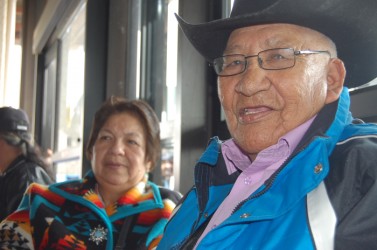Article Origin
Volume
Issue
Year
Valerie Crowshoe and her husband Ivan McMaster chose not to tell their stories at the seventh and final national Truth and Reconciliation Commission event held in Edmonton March 27 to March 30. But the event did open their eyes.
“We learned something new every day,” said Crowshoe. “I may be preparing for my healing journey.”
Crowshoe attended the Anglican Church-run St. Cyprian Indian Residential School on the Piikani First Nation from 1953 to 1960. She was taken at five years of age. McMaster was a student at Old Sun Indian Residential School, also Anglican-run, at Gleichen from 1947 to 1956, starting there at seven years of age.
“From this conference it makes me think I wasn’t the only one mentally and sexually abused,” said Crowshoe.
If the healing journey leads her to tell her story over the next year, she may get the opportunity if the TRC’s plan to hold smaller community events leading up to the closing ceremonies in Ottawa in July 2015. But if it takes longer, the National Research Centre will be available.
The NRC, which has not yet been officially named, will open its doors when the TRC shuts down. The NRC will be located at the University of Manitoba, which was awarded the contract after an open competition. The NRC headquarters will be at Chancellor Hall and will have a space to allow survivors to continue to provide their statements.
“The one thing that needs to happen, I believe, is that we must not lose sight of the survivor no matter what. I’ve seen it happen too many times where these (events) become everything else but the survivor,” said Barney Williams, Jr., one of the 10 members on the Indian Residential Schools Survivor Committee, which serves as an advisory body to the TRC.
The governing model for the NRC includes a survivors circle, as well as a governing circle, comprised of partners, universities and First Nations, Inuit and Metis representatives.
“The national research centre is also a place that is really meant to be governed by Aboriginal peoples in a lot of ways as well. This is really an important aspect of bringing control back over Aboriginal people’s records to Aboriginal people,” said Ry Moran, newly-appointed director of the NRC.
The NRC will contain documents and records from the federal government and churches that signed the Indian Residential School Settlement Agreement, along with the statements of survivors and their descendants. Gifts and statements of reconciliation that were placed in the Bentwood box will also be included in the NRC.
“These to me are very sacred items that we are talking about. They’re about people’s lives. They’re about our lives as survivors. And they’re also about our children’s lives who are very much affected by our schools and our experiences,” said Doris Young, also a member of the survivors’ committee.
Young spent 13 years in two residential schools. “It’s not just a research centre and these are not just statistics that are going to be housed in this place. This is a place of sacredness for our people…. a final resting place where our experiences are going to be.”
The development of the NRC is in its early stages, said Moran, who led a panel and open microphone discussion at the TRC event in Edmonton.
The NRC has partnerships across the country as well as with the National Association of Friendship Centres that will facilitate access to the close to four million records, which are primarily digitized. However, Moran stressed that private statements will remain private.
The centre will also serve to educate the public. While it will provide information for those who wish to advocate for survivors, it does not hold that role of advocating itself.
“This centre … cannot be all things to all people and it cannot be a continued version of the TRC… because the one thing we must help it and guard against is overreaching in the work that is so important,” said Truth and Reconciliation Commission Chair Justice Murray Sinclair.
Sinclair noted that the TRC’s mandate included gathering documents from the signatories of the IRSSA. The NRC will continue to gather that information after the TRC has concluded. But just as important, said Sinclair, is the residential school information that is archived by the provinces and other church entities, which are not part of the IRSSA.
Sinclair pointed to a flash drive that was presented to the commission in an earlier gift of reconciliation from the British Columbia government, which contained the names of all Aboriginal children ages four to 19 who died in that province between 1870 and 1984. While not all those deaths are related to residential schools, that information is now available.
Sinclair also stressed the importance of having the NRC located at a university as such institutions have demonstrated the ability to remain independent from government. He said in talks with other TRCs it was determined that governments often stepped in to block the information from being shared.
“The centre being in existence, it should not only establish a central memory around residential schools, it should also establish a memory around the experiences of Indigenous people in this country and that’s what our vision for the research centre was. It was to give it a status so that it would be a centre for Indigenous knowledge, and not only the ability to house it and to make it available, but to continue to promote it,” said Sinclair.
Photo caption: Both Valerie Crowshoe and her husband Ivan McMaster attended residential school. “From this conference it makes me think I wasn’t the only one mentally and sexually abused,” Crowshoe said.
- 2680 views

